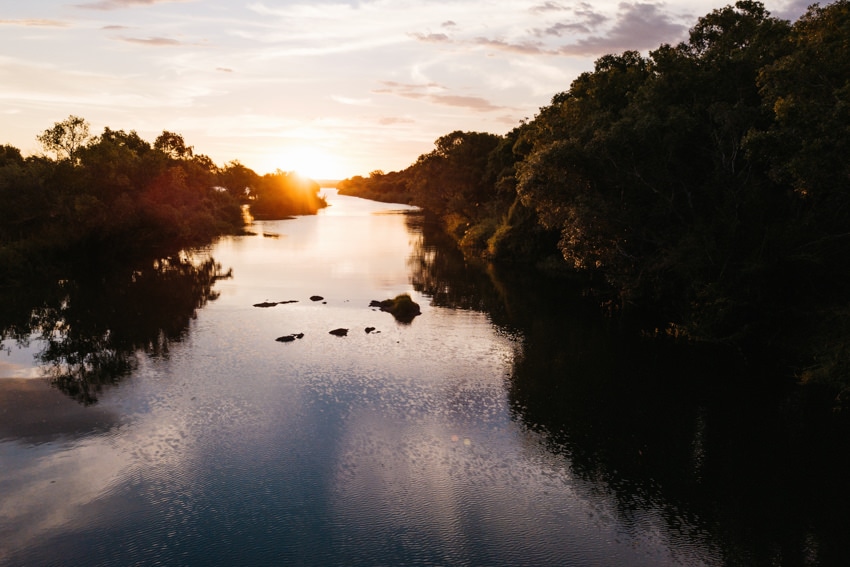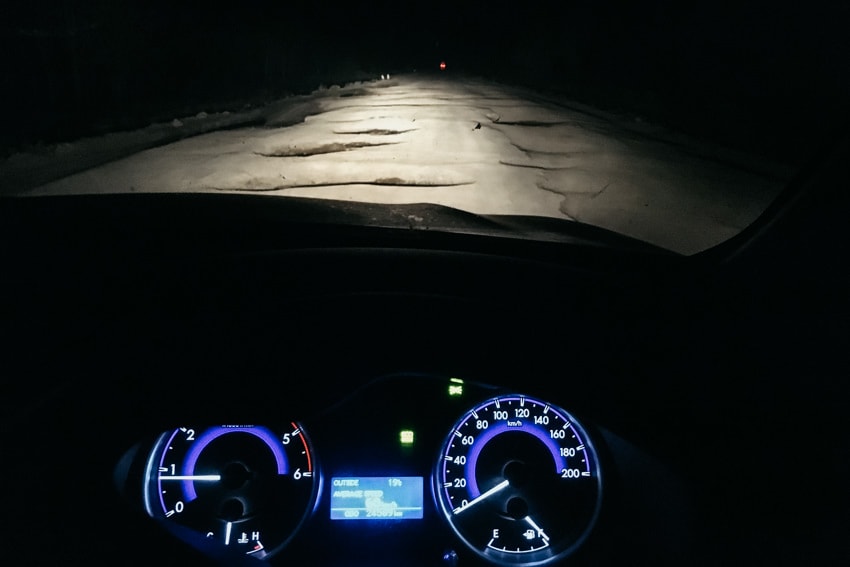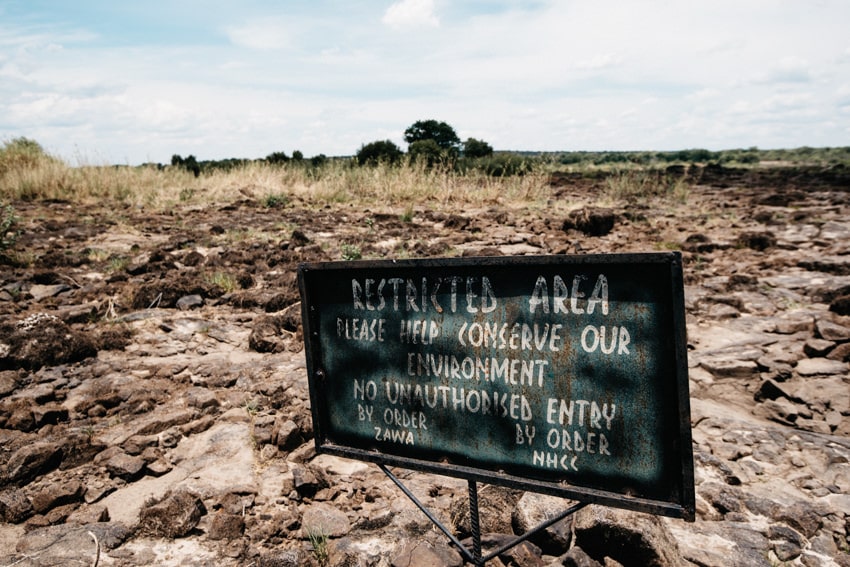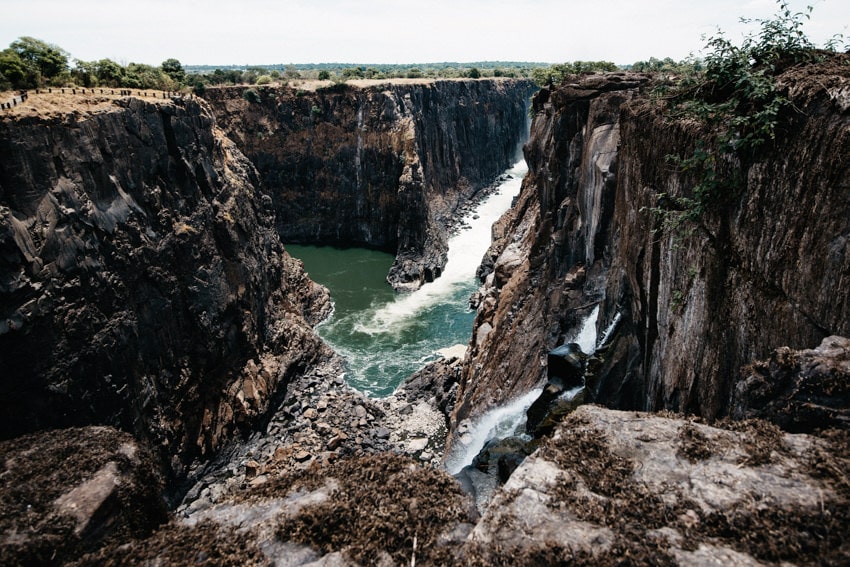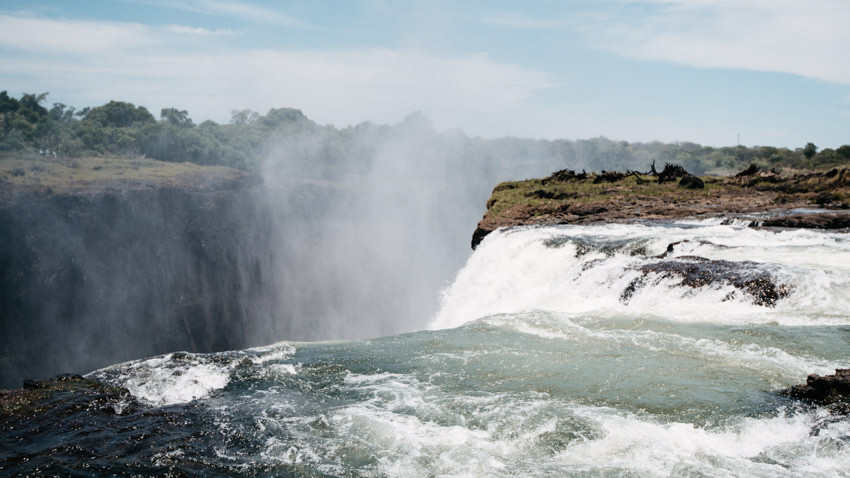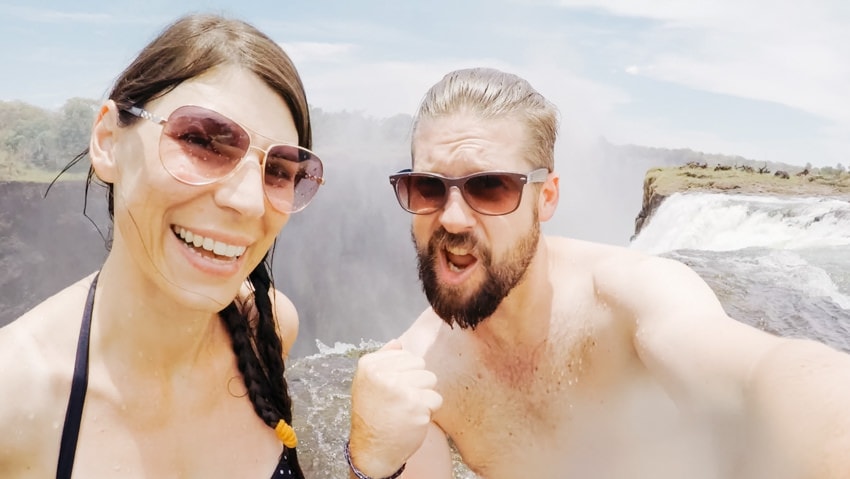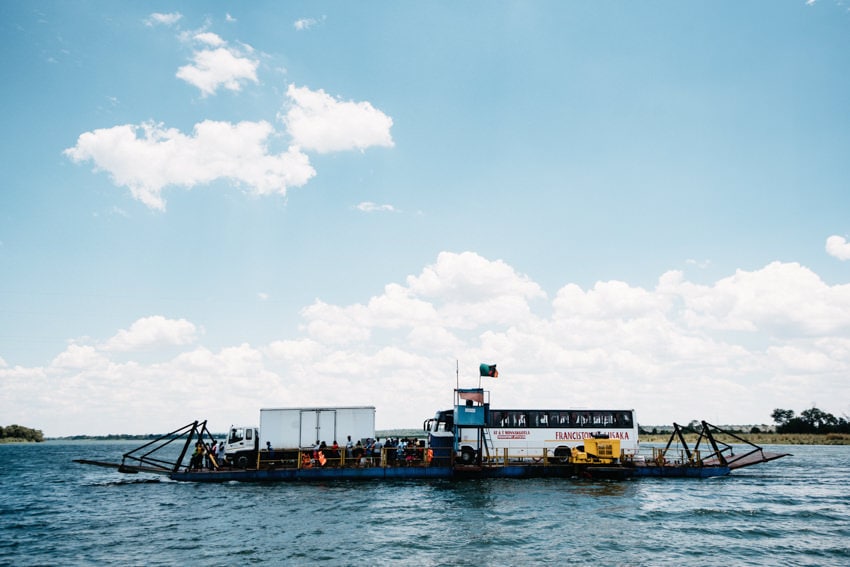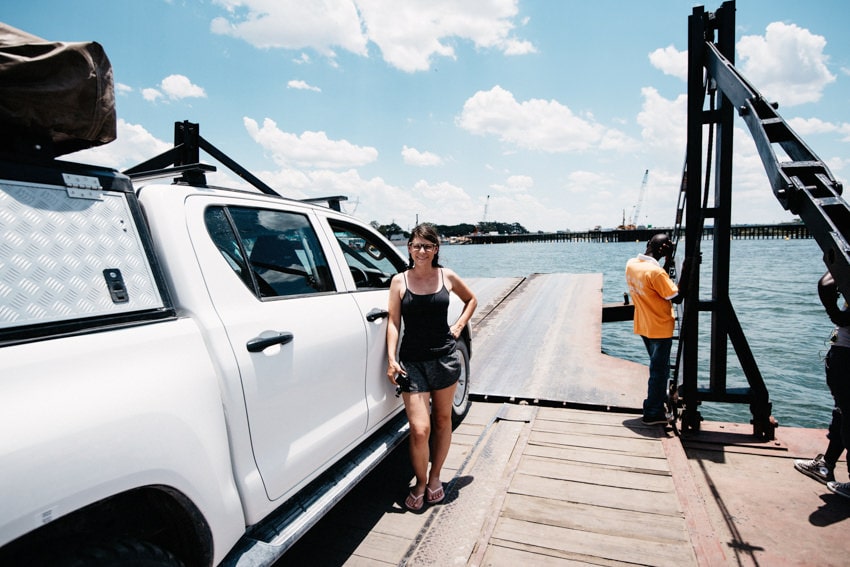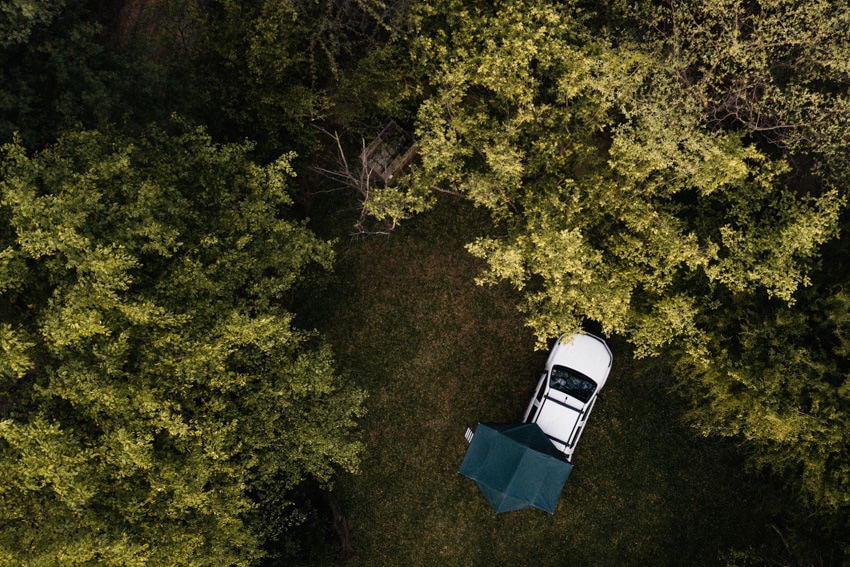Already surprised about the not-so-friendliness but pretty high “Africanness” of Nambia (complicated processes, no working systems, waiting forever for everything), we started our planned detour to Zambia – not for the country but for the famous Victoria Falls and swimming in the Devil’s Pool – enjoying life on the edge. Bianca was very disappointed when we visited Argentina last year and did not make it to the Iguazu Falls (for some reason she likes waterfalls, but, of course, does not know why exactly), so we had to go to Zambia. She did not want to do a day tour from Kasane, Botswana or fly into Livingstone, as she wanted to stay in a camp directly at the Zambesi river (why, nobody knows – well, now we know).
So, there we were, 10 hours on the road from Etosha National Park to the border between Namibia and Zambia – Katima Mulilo. The drive was very smooth – the first paved roads under our asses for a week felt so damn good (great experience moving fast forward all of a sudden), so we really drove 800 kilometers (500 miles) along the Caprivi Strip in about 10 hours. We filled up the car, ate all our dairy supplies (because we read that they were confiscated at the Zambian border – later we found out that we had mixed it up with Botswana) and exited Namibia, which was a very easy and smooth process. Entering Zambia, on the contrary, could make you think they hate tourists coming to this … well yeah, semi-pleasant area around Livingstone that is only famous because of the Victoria Falls.
Zambia and Victoria Falls
Zambia is a landlocked country in southern Africa – neighbouring Tanzania, Malawi, Mozambique, Zimbabwe, Botswana, Namibia, Angola and the Democratic Republic of the Congo. It is 9 times bigger than Austria and its landscape is dominated by high plateaus with occasional hills and mountains. Zambia features diverse wildlife and numerous game reserves, providing the country with high potential for tourism. Kafue National Park (west of Lusaka – the capital city of Zambia), for example, has one of the most prolific wildlife populations in Africa. The most famous sight in Zambia, however, are the famous Victoria Falls (a UNESCO World Heritage Site since 1989). It is called Mosi-oa-Tunya by the Kololo, the local tribe, which means “the smoke that thunders” (referring to the spray of water falling down the cliffs). It is neither the highest nor the widest waterfall in the world, but has been recognized as the largest because of its height and width resulting in the world’s largest sheet of falling water.
Here is the process that brought us into the country, to the falls and out of the country again.
Step 1: Entering Zambia via the Katima Mulilo Border
There are two ways to enter Zambia coming from the Caprivi Strip (a very thin area of land that belongs to Namibia because – and here is the very short version of the story – the Brits decided to give the Germans this land when they were actually striving to get Zanzibar).
Katima Mulilo (Namibia – Zambia):
We decided to take this route because it is the only direct way from Namibia to Zambia. With the other border (Ngoma-Kazungula), you have to enter Botswana first (Ngoma) and then go to Zambia (Kazungula). As every entering a country also includes exiting another, the process can take a long time and cost endless nerves. We learnt at Katima Mulilo that entering Zambia by car will cost you endless nerves and time although you only cross one border.
We arrived at the border shortly before 5:00 PM. We assumed that it will be tight (the border closes at 6:00 PM) because we had had many chances in the past 1,5 weeks to get to know the working speed of the average African official. Well, everything turned out to be more complicated, un-unravelable, chaotic and random than we would have ever expected. The only thing that is adjusted to the growing tourism in Zambia is the horrendous prices they charge for literally everything (we are surprise they don’t charge an air breath tax).
So here is a simplified explanation of the chaos (you may need to be a Zambian native to perceive this as an established process) we faced at the border – NO CREDIT CARD ACCEPTED:
- Health Check: You go to the “Health Check” counter, get checked with an infrared camera and receive a little paper card that you have to present to the Visa officer – he doesn’t look at it, he just tells you to throw it in a shoe box right next to his counter.
- Visa: After the health check (and given you are healthy and don’t show any signs of Malaria on the infrared camera), you proceed to the Visa counter. You have to provide your passport (the only good news for world tourers comes now: one more stamp in the passport, a pretty expensive one though) and the 50 US Dollars for the Visa (if you go for more than one day – single entry / one day – single entry only costs 25 USD). Then it takes about 15 minutes until you finally get your passport with a stamp and a receipt for the payment of the Visa fee.
- Customs: Next, you have to go to the third counter, customs (the counters are not sequentially next to each other but spread over the entire border post building, so that doubles the complication of the process). For what we paid customs – we have absolutely not the slightest idea but ok. Customs are charged according to the engine size of your vehicle. We paid 200 Zambia Kwacha (which equals 20 USD or about 17 Euros). The major problem was, that we only had Namibian Dollars and US Dollars (for the Visa) but no Kwacha. So, we had to somehow get Kwacha. Fortunately, the randomness of the paying process and the non-existence of any info about it on the internet is well known among a group of Zambian people who have developed a business model from that: selling Kwachas for US Dollars. So, we bought Kwachas for Dollars (we did not have enough for everything so we just gave them everything we had and told them that was a good deal, which they denied but they saw we had given them everything so they were ok in the end).
- Motor Insurance: The fourth counter is motor insurance (whatever this is – we have no idea, does it insure Zambia against the gases and fumes we blow out of our car or does it insure our motor of Zambian roads – probably, it is just another random fee that Zambian smartasses have developed to rip off tourists), 500 Kwacha (50 Dollars – 45 Euros, to be paid in Kwacha). As we did not have enough money to pay the Kwacha-dealers, they told us that there was also an insurance for one month that only costs 427 Kwacha (of course they don’t tell you they charge you 500 for three days – hahahahaha). So, we confronted the motor insurance officers with our newly gained knowledge and insisted on getting the insurance for 1 month. Reluctantly, she gave it to us – Bianca gave her 500, she gave her 70 Kwacha back and was sorry she had no more change. After Bianca insisted she wanted to have the 73 change and if she doesn’t have 3 Kwacha, she would also take a 10 instead, she gave her 80 Kwacha back. So, yeah, there is that.
- Road Tax: The last tax (well technically the second last but we did not pay the last one as we did not have a dime left – some kind of random tax a lady wanted directly at the border in order to open the gate) is the road tax – the most expensive and, given what kind of road we saw us confronted with right after the border, the most ridiculous one. We paid 38 US Dollars (NO KWACHA, NO CREDIT CARD ACCEPTED) and were good to go.
For each of the payments you receive a highly official proof of payment (the paper of the road tax receipt seemed very high quality to us – that is obviously where they spend the revenues – surely, not on building good streets). You need to keep the receipts because you may need them when exiting Zambia.
Ngoma – Kazungula (Namibia – Botswana – Zambia):
The other option is the Kazungula border crossing, but as already mentioned above, it requires to exit Namibia and enter Boswana at Ngoma and then exit Botswana and enter Zambia at Kazungula. The fees are basically the same, just that you have to cross the Boswana-Zambia border by ferry, which costs extra. So it is even more complicated and expensive than the other version but, the street on the Zambia side is very good – so, in the end, this option may save you about 3 hours.
Step 2: A Hell of a Ride – Katima Mulilo to Livingstone
In the end, we were lucky we got to the border so late that they were already closing down. Otherwise, they would maybe have kept us the entire day there telling us we needed more money to pay for all the fees. So, it was 6:00 PM when we started our tour to Livingstone. We decided to go there as we had not booked a camp for the night and thought the chances to get a free camping space would be the highest in Livingstone. The GPS said 2 hours – so we thought we could make it before the final sunset. When we started to drive, the GPS kept on telling us to turn around – it was actually trying to get us back to Namibia and to Zambia via the Botswana border. We decided that was bullshit and continued the “wrong” way. Only 10 minutes later we knew why the GPS was smarter than us. The road we faced was so super-bumpy and riddled with potholes that were no potholes but looked like waterholes that easily fit an entire adult hippo in rainy season. So, for 120 kilometers / 75 miles (that is where the road gets better) it took us 4 hours – yes, 4 hours. What a hell of a ride. Bianca thought she had broken her neck but when she realized she was still alive, she knew it was just her vertebra from the neck that had moved down to her hips. After about 160 kilometers (100 miles) we, coincidentally, passed the camp we had booked for the next 2 nights and were lucky because they were still open and gave us a spot to camp (of course, after they had checked their booking sheets for about 15 minutes to find out if there is a spot available – there was and, as it turns out, we were the only campers on a huge campsite that night).
Step 3: Organizing a tour to the Devil’s Pool
The next morning, we woke up and were motivated to get the tour to the Victoria Falls and Devil’s Pool done. We thought we had experienced enough of the Zambian cabaret (funny in hintsight but no so funny at the moment of consumption), so we were ready for some refreshment. Ahhhhhhm, yeah, that was a good plan but we made it without the Zambian people. We went to the tour office at the Victoria Falls World Heritage Site and wanted to book a boat to Livingstone Island, where the pool is located (the tour is only offered in dry season – September to December – as it is too dangerous to swim in the pool in rainy season). Boat tours were sold out – so they sold us the walking tour over the falls (when the falls are dry you can walk on them) for 95 USD – so basically the same amount of money as the boat tour and, and this is the most incredible part, almost as expensive as a full day boat to the Outer Great Barrier Reef in Australia including pick-up and drop-off, a guide, food and drinks. As we had spent all our money just to arrive in Zambia, we were eager to see the falls and swim in the pool – so we accepted the price and booked for the next morning. When we got back to our camp, the owner told us this tour was not official and it is highly recommended to only go with an official tour – so she booked us on the morning tour with Tongabezi Tours the next day. This tour costs 100 USD per person but is highly official – so we thought: why not, if it is safer. Then, all of a sudden it was fully booked, so we decided to go the day after. The next day, she told us the tour got cancelled and there was only a noon tour the next day (of course, Zambian logic: if all tours sell very well and are always fully booked, why not cancel it). We couldn’t do this tour though because we needed to cross the border to Botswana and reach our camp in Chobe before sunset. We were totally disappointed that our lodge owner called the tour operator again to get us on any tour. As there was no chance, she called the tour desk at the National Heritage Site (the tour she told us is dangerous and not official) and booked us on their noon tour on the same day. To put it in a nutshell, in the end, we did the tour we had organized on our own for sunset (beautiful light, romantic atmosphere) at noon (worst light and burning heat). Now, that we had the tour organized we had to get the money.
Step 4: Withdrawing and Exchanging money in Zambia
Getting money in Zambia is as hard as driving from the border to Livingstone – briefly, almost impossible. Firstly, we went to the Stanbic Bank (that seemed very trustworthy) but the ATM was out of order. So, we went to the next bank, Barclays Bank. This bank seemed to have money because there were about 100 people lining up in front of the ATM and the bank to get money. So, we decided not to line up because we expected the bank to be out of money once we had eventually made it to the front of the line. Next to Barclays bank there was another bank – not that trustworthy but obviously a bank. We really succeeded in withdrawing the 1.900 Kwacha we needed for the tour, so we took the money and left. We did not want to withdraw more for the moment, as we had heard we needed dollars for the border crossing to Botswana but thought we could also do it later (and we had no intention to spend more money in Zambia than we needed to – so shopping for groceries or fueling the tank was not an option) and our lodge owner told us that there were banks where you can withdraw dollars at the ATM (which was actually bullshit and is, of course, not possible). When we wanted to leave the parking lot, a guy stopped us and told us parking was 2 Kwacha. Oh no, we had parked our car at the only parking lot in entire Livingstone where they charge you. Bianca discussed the entire situation with the guy, but he did not show any sign of compassion or understanding so we had to pay the 2 Kwacha. That left us with the situation that we missed 2 Kwacha for the Devil’s Pools and couldn’t find any ATM that gave us more money. So, we decided to play it very hard, leave all our dignity behind and ask the lodge owner for 2 Kwacha (which equals 20 Euro Cents).
The next morning and 2 Kwachas richer (earned from begging) because our lodge owner was very kind and gave us the money, we still had to get more money to be able to cross the border to Botswana. As we had learnt at the border to Zambia, US Dollars will get us through. So, we had to get dollars somehow. We went back to Stanbic bank and hoped the ATM would work this time. It actually did but unfortunately it had a very strange but serious system error – you could type in the PIN Code and the amount of money but then there was only a “Cancel”-Button but no “Proceed”-Button. So, we went to Barclays Bank, the ATM was not out of order but it had no cash. The next bank on our list was the African National Bank, which seemed good because it also had a Bureau of Exchange inside. We thought that was great because we were gonna withdraw Kwacha and change it into US Dollars right away. Surprisingly, the ATM really worked, was not out of order and it had cash and a Proceed Button. Unfortunately, after waiting in line forever, we learnt that the Bureau of Exchange had a system error and were, therefore, not able to exchange foreign currencies. So, we were off to the next bank, a bank with such a complicated African name that we cannot remember what is was called. After waiting another 20 minutes in line, the lady at the exchange counter said she could change the money. After typing in the transaction into her system (10 minutes) and filling out many papers (10 minutes – Africans love documentation on paper) and seeking many signatures of her boss on every sheet of paper (10 minutes), she found out she did not have enough dollars. Instead of 200, she only had 195. So, we took the 195 and the rest in Kwacha and left the bank. It is completely crazy but it had taken us 2 hours to get the money and the USD.
Step 5: Swimming in the Devil’s Pool / Victoria Falls
In the end, we did the walking tour to the pools, which was not dangerous at all because there was absolutely no water along the entire way, just at the very end there was a little swimming/going through the water-part. If they tell you to keep your shoes on before entering the water, you better take them off because you really don’t need them. The walk takes about 30 minutes until you reach the water. You walk over the stones of the waterfall, it is completely flat and a very easy track. The swimming part is equally easy – Bianca is a really bad swimmer (if she swims she almost looks as weird as when she runs – very entertaining to watch) and she managed it easily. Well she hit a stone with her foot and hurt it very bad when she was swimming although the guide had already said that the water gets very shallow and we were supposed to walk from now on – it left her with a huge bruise and an even huger bump on her foot – but that was really her fault. Then you eventually reach the little but dangerous Devil’s Pool – right on the edge of the falls crashing down the cliffs. As soon as you go inside you can feel the really strong stream. The water is not cold not warm – just perfect for a little refreshment without brain freeze and breathlessness. It was totally worth the trouble, during the 15 minutes in the water we actually forgot everything that had happened before. The view down the falls is stunning and it is a unique experience. The guide takes lots of pictures (at no extra cost!) – just remember to provide him with a smartphone or an easy-handling camera but not like Tom a super-exclusive Nikon D750 that he could barely hold with one hand and that he was not able to get one shot with that was not totally blurred to the moon and back – so no pictures for us. Thank God, we brought our Go Pro with us so we got a good video instead. After the little swim – which is technically not a swim but more a bath, you climb out (towels are provided), get changed, receive a cold coke (surprisingly included in the completely overpriced price of the tour) and walk back to the entrance of the National Park. We are glad we did it and can tick it off our bucket list as we will never come any close to Zambia again (at least, not voluntarily). After our little swim, we walked along the Victoria Falls Heritage Site with its many viewpoints to the falls (Devil’s Cataract, Rainbow Falls, …) and with good opportunities for taking pictures.
Step 6: Leaving Zambia
Provided that the immigration process is so complicated that one could get the impression, they do not want any tourists in their country, the emigration process is surprisingly also very difficult. So, if you managed to get in, you are actually really only half way through – getting out is also a huge thing. We left our camp in Zambia around 11:00 AM to make sure we have enough time to get out of Zambia and still immigrate to Botswana and reach our camp in Chobe National Park before sunset. We had talked to as many people as we could talk to about the process at the border (not the one that we entered through because we entered via Namibia and exited to Botswana) but they all told us a different story concerning fees, time, ferry costs and the process itself. So, we decided to take enough time to manage everything and bring enough US Dollars to pay for all the hidden costs but not too much knowing they might take everything we have.
As we approached the border post in Zambia, a guy that wanted to help us to manage the process (of course, for the one or other US Dollar) had quickly assigned himself to us. We tried every strategy that came to our minds to get rid of him (as we did not want to pay a guy from Zambia that helps us through a process that is obviously so stupid that we cannot manage it on our own but only with the purchased help of a guy from Zambia) but we failed. He followed us and told us everything we needed to do.
So here is a simplified explanation of the chaos (you may need to be a Zambian native to perceive this as an established process) we faced at the border – NO CREDIT CARD ACCEPTED:
- Emigration: You show your passport, they write down the date and you are good to go. No hidden costs and pretty fast.
- CIP – whatever this is: Next, you proceed to CIP (yes, like the Incoterm) and pay – surprisingly nothing and you still get a stamp. We were already starting to have the feeling of very slight delightment, when we had to move to the next counter.
- Local government tax: Here you have to pay 30 Kwacha – in Kwacha – no US Dollar, no credit card for the local government. Bianca, of course, insisted on getting to know what she pays for and what happens with the money but the guy, of course, couldn’t tell. As she was sure it’s bullshit, she put on her well-established show “I am very sorry officer but I don’t have any Kwachas left” – which was actually partly true because we only had 28 lacking exactly the 2 Kwacha we had to pay for parking the other day and that we already missed when paying for our tour. He remained at his standpoint that it was an official tax and has to be paid without exception. She tried to negotiate down to 28 Kwacha but then it got too exhausting and we luckily found a 10 Kwacha bill, so we paid and left – no, not the bloody country – to the next counter.
- Ferry: Currently, a bridge is being built to Botswana, which is actually pretty smart as the Zambesi is only about 200 meters wide (650 ft) at the place of the border crossing. There is a ferry operating between the two sides (it takes 10 minutes to cross) but unfortunately, it can only carry one truck and one car at the same time. So, there are always about 100 trucks waiting in line to get on the ferry (how long it takes to get it from one side to the other? We don’t know, calculate it yourself!) but cars are allowed to pass. We thought, cool, that is really cool of Zambia that they have cars pass but getting on the ferry we determined what the real reason was. The ferry can fit one truck and one car, but not two trucks at the same time. So, if there is one truck going but no car, 1/3 of the ferry remains empty. Anyway, we paid 150 Kwacha (15 USD or 13 EUR) for the ferry and were good to go. US Dollars are also accepted at this counter, but then it cost 30 USD.
We passed the gate to the ferry, where they really check if you paid the CIP fee and the ferry and went on the ferry right away. The border crossing process into Botswana was very easy and we were glad to we had made it out of Zambia – with four kidneys and even 100 US Dollars left in our pockets.
Our TOP TRAVEL HACKS for visiting Victoria Falls in Zambia
- Do not go there
- If you really want to got there, think about it one more time – what’s in for you?
- If you really want to go there after considering and reconsidering, do not go by car. If you really want to go there by car, plan a longer stay and visit more places than just the Victoria Falls. Otherwise, the costs to enter by car and the hassle at the border is just no worth it.
- If you really want to go there after considering and reconsidering and excluding the car as an option, do not go there by airplane. Flying in will definitely save you nerves, but no time or money. You can fly into Livingstone from Joburg (the airport where Bianca’s bag decided to get lost) but it costs you, for sure, 100 Euros per person (maybe you can get a better deal by booking way in advance or really close to the date when you will be going but it will probably not be a lot cheaper than this). Furthermore, if you fly you will most likely spend more than one day, so you cannot grab the 1-day visitor visa (25 US Dollars per person) but will have to take the one for 50 US Dollars per person. You will also need to spend more money on overnight stays. You could combine it with a trip to Zimbabwe (where the falls also carry water when it is really dry), watching the falls from both sides but crossing the border will cost you another 50 US Dollars per person for the visa and we don’t think it is worth it.
- The most efficient (time, money and nerves) way to visit the falls is definitely by doing a day tour from Kasane (starting at 450 Botswana Pula for a day tour – which is approximately 40 EUR excluding the Visa fee) in Botswana. This, however, requires your own car but you can combine it very well with a trip to Chobe National Park and the Okavango Delta – so, this is definitely the best option to get to enjoy the Victoria Falls.
To put it in a nutshell, we recommend skipping the Victoria Falls (leave it on the bucket list – that is where they fit best) and visiting the Iguazu Falls instead.
Zambia, it was a pleasure! You really made us feel completely un-welcome. You made us understand why third world countries are developing slowly and can barely make it out of the third world – countries where local, federal, state and whatever governments are cashing high fees and taxes that, at the end of the day, never reach the people of the country, leaving behind a few better off officials and politicians and a vast number of very poor people that fight daily to survive hunger, thirst and bad health standards. Our trip cost us 20 % of the annual Zambian GDP/capita – we hope you start spending the money wisely soon so it makes a little sense that you rip off tourists and drive them f… nuts with your senseless fees, taxes and processes. And last but not least, Lesotho – you are a third world country as well but YOU ROCK!!!
Our overnight stays
We stayed about 11 kilometers (7 miles) outside of Livingstone as we don’t like cities very much and Bianca really wanted to have a campsite on the Zambesi River. The camp is really nice, it is gated and there are lots of guys running around all the time checking the camp for animals. It has a very nice shower/toilet facility that is more or less open air, very clean and just nice. Sinks are also provided for the dishes. It also features a very nice restaurant and a bar with a huge terrace that offers a wonderful view directly on the Zambesi and a very delicious dinner (however, highly overpriced). Getting into Livingstone/Victoria Falls is very easy as it lies only a short drive off the main road into the city.

